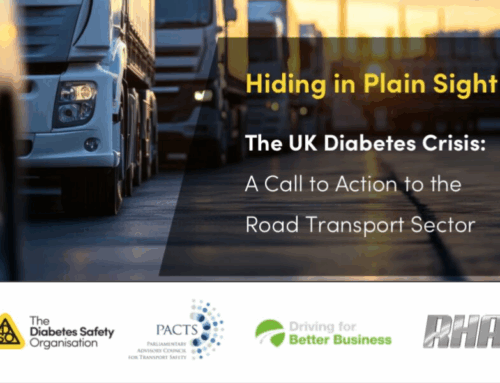In the first part of this three-part feature on driver wellbeing, Kevin Robinson examines the impact which poor management of mental health can have on our drivers, and the costs to our fleets.
In society, mental health is becoming something we are all becoming more and more aware of. High profile campaigns such as Head’s Together, whose patrons are the Duke and Dutchess of Cornwall and Prince Harry, have now brought the subject to the fore of our consciousness.
In construction alone, suicide and mental health related deaths far outnumber those which occurred as a result of a workplace accident and, when founding his ‘one for the boys’ charity, Hollywood actor and mental health campaigner Samuel L. Jackson said, “Men talk about their injuries, they don’t talk about their health.”
What is mental health and what effect could it have on those who drive within my business?
To many, poor mental health is a phrase associated with straight jackets, padded walls and laying down on the shrink’s couch. However, in truth, the real picture of mental health couldn’t be farther from the truth.
Many of us at some point will suffer from some form of mental health issue, with official figures ranging from 1 in 4 at the more serious end of the scale, resulting in the need for intervention, to 75% at the lesser end with mild depression and mild anxiety.
Recently Prince Harry along with former international cricketer Andrew Flintoff and rap star Professor Green have spoken of the impact which anxiety had upon their lives and their ability to perform at the highest level.
When looking at how this can affect our driving, let’s use the following example: Many of us drive to and from work each day, with the majority of those journeys being in the region of half an hour.
Taking that into account, think back to your journey into work this morning. You were probably stuck in traffic for part of it. Chances are you may have had to brake hard, thanks to some other idiot motorist, or swerve to avoid a cyclist but, on the whole, it was pretty normal and, when asked, you would say it was a smooth but unremarkable drive in barring the odd incident, and your concentration levels were good.
Now think about that journey again, only this time, factor in the news that your partner had told you last night they were having an affair, or your 15 year old daughter told you she was pregnant. Do you really think you would be concentrating on the road quite so much? Would you still be able to avoid that cyclist who came out of nowhere or the driver in front who stood on the brakes at the last minute? No, of course you wouldn’t and who could blame you?
In all honesty, with that type of distraction, most of us would be anxious at the very least and probably unable to carry out simple tasks to the best of our ability.
Fast forward a couple of weeks from the news, and the likelihood is that we would become depressed, withdrawn and probably struggle for sleep. All of these, believe it or not, are signs of poor mental health and all of them can make us a liability on the roads.
Supporting this is research carried out in 2017 by Mercedes-Benz, which found that of 2000 van drivers surveyed 1 in 5 described their current state of mental health as poor.
So why has it taken so long for wellbeing to be recognised alongside safety?
The answer to this one is simple. Safety brings instant rewards while wellbeing is a slow burn. It’s much more difficult to spot problems and sometimes it can take a long time to see the benefit of interventions.
For example; if you have a problem with rear end shunts in your van fleet from drivers speeding too often, you could fit telematics to your vehicles, and make your drivers accountable for their driving style. Positive changes with both reductions in speeding and subsequent crashes should start to happen fairly quickly.
This approach is the very simple problem/solution model, but wellbeing programmes are different but no less important. Improving the mental state of a driver means they are less likely to be stressed and are more likely to maintain their concentration and make better decisions on the road.
Can work be a contributory factor?
Undoubtedly. In fact, looking at the Mercedes-Benz Survey again, of those who described their state of mental wellbeing as poor, three-quarters of those respondents also said that work was a contributing factor.
So why is this, what has changed?
Well, half of van drivers polled say increased time pressures (52%) and increased workload (50%) are affecting their state of mind, a theory which is supported by Steve Bridge, Managing Director for Mercedes-Benz UK Vans.
He said, “With a continued surge in online shopping, an increased reliance on same-day deliveries and spiralling traffic volumes across the UK, the real-world pressures on van drivers are changing.”
“Our research findings act as a clear call to van drivers to talk about their mental health concerns and work pressures with their employers and for employers to actively listen to the real concerns of their workforce.”
The Lonely Life of ‘White Van Man’
The life of a van driver has always been a solitary one; but can this play a part in a state of poor mental health? Mental Health Foundation spokesperson James Harris feels so,
He said, “compared to the national average, these figures indicate that van drivers are experiencing an increased rate of poor mental health.”
“In part,” he continued, “this may be explained by the pressures of the job, and the fact that van drivers can often be isolated.”
“This is important because we know that men are less likely to reach out for help, and are four times more likely to end their life by suicide. We need to create a culture in which anyone experiencing problems can ask for help in the knowledge that they will be supported.”
In conclusion
As an employer you may never see the benefit of good mental wellbeing within your organisation or be able to directly attribute accidents to poor wellbeing, however, taken as part of a bigger picture the benefits surely outweigh the cost.
The battle will always be with those controlling the purse strings – the cost vs benefit of raising the awareness of organisational mental wellbeing.
Driving in itself is one of the most stressful activities we undertake as part of our working day and probably one which requires one of the highest levels of concentration given the number of variable factors which can confront us on a daily basis.
Taking that into account, and given the risks of a lack of concentration, would you be happy with somebody performing brain surgery on your daughter if you were aware they were not 100% focussed on the job in hand.
The same applies to those within your organisation who drive as part of their daily life.
Distracted drivers are bad drivers and those with poor mental health are scientifically proven to be as distracted as somebody who has consumed excessive alcohol.
In part two of this feature, coming soon, I will look at how to spot the signs of poor mental health in your workforce.
Driver wellbeing is one of the issues being looked at in this year’s Van Excellence Operational Briefings.
https://www.fta.co.uk/events/Van-Excellence-Operational-Briefings-2018.html
Extracts taken from the Parker’s Article One in five van drivers suffers poor mental health published 17th May 2017





